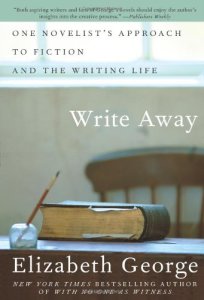I just started to use my MacSpeech Dictate program and I have to say I’m impressed. I am standing away from the computer talking into a microphone, not even looking at the screen. In a few minutes I will go over and see what in fact has appeared.
I can’t believe it. It’s perfect.
So now what? I wish I had some research notes to test. Okay. I’ll talk about Elizabeth George‘s book Write Away.
I like this book: she details the professional nuts and bolts of her way of writing a novel. She’s candid and honest and not too abstract.
For example, she writes:
“To give myself a sense of direction, I do two things. I create a step outline. I then expand it to a running plot outline.”
I find this interesting. Right now, I’m creating (in brief) scene ideas which I will, at some point, arrange in the order I think they might unfold in my novel. I am a long way from the making-order stage, however. Right now I just imagining scenes, one upon another. Soon, I will begin to think about ordering these scenes.
“Every scene contains something within it that triggers a scene that follows.”
She can type her step outline on a single sheet of paper, and it doesn’t take her longer than a few hours. It’s confessions like this that make me feel like a wimp!
However, having now read the entire book, I understand how much preparation she’s done before creating the step outline:
1. Idea: basically, the story described in one long paragraph. I find this one paragraph impossible to write. I’m still looking for the idea, no doubt casting my net too wide.
2. Research: once she has an story idea sketched out, she begins her research, which is extensive and well-organized (I am impressed).
3. List of characters: she lists all the possible characters in the novel, giving careful thought to their names.
4. Detailed description of each character: her documents describing each character are extensive—three or four single-spaced pages long. I always mean to do this, but never do.
5. Develop settings: layout, photos, maps, etc.
6. And then—the step outline. She aims for 10 to 15 causally-related events, noted down in abbreviated form.
I thought: okay, I’ll give it a try—see if I can come up with a short list of linked events. But no way: it’s hard. She’s a thriller writer, so that surely must help.
More on this to come.
(I’m finishing this post in a café in Berkeley. I just stocked up on my new favourite pen—a bold Uni-ball Gel Impact RT—and my long-time favourite pencil, Twist-Erase with a .9 lead. Plus a lovely grid-lined spiral notebook, one of the many I buy and never use. This is the store I remember buying stacks of tiny cards for French vocabulary as a pre-teen. It now has a sign on the door, “This is a soft building”—a warning in case of an earthquake.)




Cool that your speech programme works. I’ve not had much luck with Dragon Naturally Speaking, but it could be that I don’t have a good enough mic.
Thanks for sharing the EG info – really must dig into my own copy of the book!